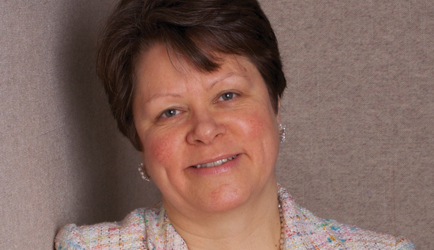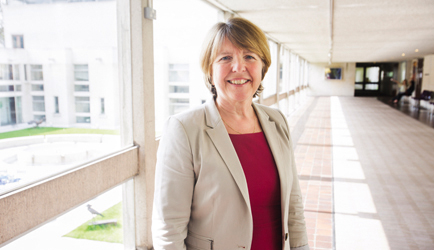High flyer: Much of Dowling's research has focused on reducing noise from aero engines
Four weeks into her tenure as the first female president of the Royal Academy of Engineering, and Dame Ann Dowling looks perfectly at home in her office amid the genteel environs of Carlton House Terrace in London’s St James’s.
She has not given up the day job, and is dividing her time between continuing to oversee the engineering department at the University of Cambridge and taking on a planned five-year stint as leader of the academy. She has bought a flat in the capital with her husband, she says, and knows the city well.
It seems her appointment as president has come at the right time. “I was delighted to be asked,” she says. “The academy has so much potential, particularly in terms of being an influence on government and policy. It also has the chance to help change engineering: the way in which it is viewed, and the number of youngsters coming in.”
Dowling, who is professor of mechanical engineering at Cambridge, has a distinguished career in academia, much of which has focused on reducing noise from aeroengines. Her research is primarily in the fields of combustion, acoustics and vibration and is aimed at low-emission combustion and quiet vehicles. She studied maths before training as an engineer, and says the situation for women in the sector is much changed from her early days, when only a handful of girls were on engineering courses.
Does her own career exemplify what can be done in the sector by women, I ask? “Engineering has been a fantastic opportunity. There are some great jobs out there, really exciting and creative careers. It’s such a shame that women are missing out.”
She says that 27% of first-year general engineering students at Cambridge are now women – well above the national average. The fact that the course is not specialised, and not forcing people to narrow down their options early on, may help. There has always been a shortage of women in the sector, she adds, so those that are keen, bright and motivated tend to do well. But the average number of women in the sector across all ages in the UK is still shockingly low, at 7% – the worst figure in the European Union.
Dowling acknowledges that the skills crisis is the worst problem afflicting the industry. It is something she intends to make an impact on during her time at the academy. Attracting far greater numbers of women into the profession could obviously help. She says: “We are only producing half of the new engineers and technicians we need. We have been talking about skills shortages in the future, but they are biting already. What we have to do is work together to make sure there are more engineers coming in.”
She says there will be a massive gap as early as 2020. “To make a difference in that timescale, you are talking about involving people who are already studying A-level physics, or about to be. It doesn’t give you a lot of room for manoeuvre.”
Engineering UK believes it will be around the end of the decade before it is clear whether the Big Bang fair is increasing the number of youngsters studying Stem subjects at college and university. Dowling points out: “There is a realisation that engineering can solve a lot of society’s problems, such as how to secure energy supplies, and how to replace ageing infrastructure. Engineering’s flag is flying really high at the moment. We need to make the most of that.”

Dame Julia King
Like Dowling, former Rolls-Royce engineer and executive Dame Julia King has enjoyed a stellar career in the sector. She has been vice-chancellor of Aston University since 2006. King was also principal of the engineering faculty at Imperial College London for two years. She worries that a resurgent industry will simply not have the numbers of engineers to cope with demand. “We need something like 50,000 engineers a year over the next 10 years, and are graduating less than half that,” says King. “Fifty per cent of the people who sit physics at GCSE level are girls; by the time we get down to A-levels that is at 14%, and by the time we get to employees, professional engineers, it is 7%. Clearly there is a huge area of opportunity if we can get more women to study and stay in physical sciences and engineering.”
But change is necessary, she points out. There is what she describes as a “subconscious bias” against women in the sector. “This isn’t a finger-pointing thing,” she says. “But quite unintentionally, I think most of our engineering companies could be described as institutionally sexist. If you have an industry where only a small minority of the professional engineers are women, it is hardly surprising that you have a subconscious image of an engineer being a man.”
She adds that when engineering leaders are appointed, this bias tends to apply – whether people like it or not. “Unless we continually question that, research shows we do what our subconscious mind thinks we should do. That image has a very strong impact on how we assess candidates.”
She adds: “I was brought up in that environment. Just because I’m a woman doesn’t make me immune to it. You have to keep reminding yourself – and other people – that we all do this.”
It is not that female engineers are by any stretch less able than their male counterparts. For instance, King says, they tend to achieve better rankings in appraisals – and yet get passed over for management positions. “That is because of that subconscious bias. It is more prevalent because engineering is such a male-dominated profession in this country.”
It is unhelpful for women who do make it to the top to make light of their experience, she adds. They can be shy about saying they have experienced sexism, for example. “I experienced some very sexist remarks and environments.” She says she notched up firsts in every year she was studying at Cambridge. “My male tutor asked me what I wanted to do and I said I wanted to be an academic. He said: ‘I can see you as a polytechnic lecturer’. Here I am, about to get a triple first at Cambridge, and he didn’t think I could do the job he was doing.”
King adds that she is a “natural fighter”, which saw her through such discouragement. “I bounced back, and thought, ‘I’ll show you’. We need to make sure we give girls the confidence to do that. I’m not sure our education system is good at instilling confidence in women and girls. We need to address that.”

Numbers game: Half the students at Stocking's all-female college are studying Stem subjects
Dame Barbara Stocking, president of the all-female Murray Edwards College in Cambridge – where around half the students are studying Stem subjects – says that separating female from male students for the first two years of degree-level supervisions helps them to progress more quickly, and become confident.
“Our girls say that by the time they get to the third year, when they are likely to be in mixed supervision, they have the confidence to know what they know and can operate and express ideas. Sadly supervisions can be dominated by men,” says Stocking.
One answer to the lack of women studying engineering could be to have more single-sex Stem classes at school. The evidence suggests that girls at single-sex schools perform better in science and maths and stay on longer than those in co-educational schools. Perhaps, then, single-sex classes could be introduced in co-educational schools to boost the numbers of girls engaged in Stem. King suggests that she “wouldn’t necessarily advocate more single-sex schools. But you might look at mixed schools where you separate the genders out for certain lessons. It does help to encourage girls. It’s a solution – a pragmatic one, in my view.”
There is also some evidence that independent schools produce more female Stem students, which may be down to greater aspiration and encouragement at home, as well as superior schooling. Good teaching is crucial, says Stocking. “If you are a good teacher, male or female, you will do what you need to do to encourage girls.”
Stocking says that the level of female engineers in the former Soviet Union was around 50%. The notion that women cannot do the job or are less able than their male counterparts is erroneous.
Dame Julia King points out that in wartime women performed engineering jobs and “did them perfectly well”. She says: “The Women’s Engineering Society was created out of the First World War – and the fact that women were so unhappy about being pushed out of their engineering jobs.
“There are differences between cultures, regions and countries,” she says. “We know it’s not anything genetic about women in the UK. We know they are just like everyone else, and can do these things when they are shown they are needed, or when they are given the opportunity – and when the environment is one they feel comfortable in.”
Issues for working mums
A large majority of women hoping to return to careers in science, technology, engineering and mathematics (Stem) after a career break have said they face significant financial barriers, according to a new survey.
The cost of childcare and inflexible working hours were the main barriers reported by the 5,000 respondents to the survey run by the scientists’ union Prospect, in conjunction with the Talent Retention Solution, Women in Manufacturing and the Women’s Engineering Society.
The union’s 14,000 female members in Stem-related occupations were among those invited to take part in the survey, which sought responses from a range of sources – including universities, networks such as Mumsnet, and professional institutions including the IMechE.
The aim was to understand the barriers for women entering or returning to a career in Stem, and what can be done to overcome them. More than half (52%) of respondents said the cost of childcare was a barrier, while more than one quarter (27%) said the lack of flexible working options – such as flexitime, job sharing and part-time work – was a problem.
Sue Ferns, Prospect’s head of communications, says: “Women in Stem want flexible working opportunities, more accessible career paths, top-up training and mentoring support. These things would actually benefit the whole workforce.
“Stem women are an under-utilised talent pool. Many returners report barriers or say they have no idea how to get their ‘feet back in the door’. Yet we know from existing good practices that removing these barriers is eminently achievable, it is just that the pace of change is nowhere near quick enough.”
According to a recent survey by engineering software firm MathWorks, more than 81% of academics working in Stem-related fields believe it will take more than 10 years to bridge the skills gap in the UK, an increase from 68% in 2013. Additionally, 45% believe it will take more than 20 years to bridge the skills gap, with some academics commenting that the UK will never bridge the Stem skills gap.
The survey emphasises the important role that Stem postgraduates play in economic growth by driving innovation, undertaking research and providing entrepreneurship.
The survey reveals that: 91% of academics agree that the UK must bridge the skills gap to be competitive in the world economy; and 82% believe that there are not enough skilled candidates to meet employer requirements.
Academics surveyed believe the main reasons for the Stem skills gap are:
- Not enough collaboration between industry and academia
- Not enough focus on project-based learning in secondary, further and higher education
- The base of students is not diverse enough
- Investment in the teaching of Stem in further and higher education is not as high as in other countries.